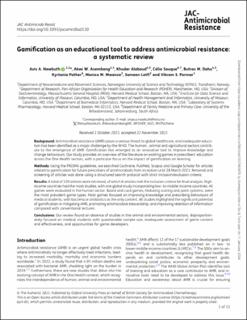| dc.description.abstract | Background
Antimicrobial resistance (AMR) poses a serious threat to global healthcare, and inadequate education has been identified as a major challenge by the WHO. The human , animal and agricultural sectors contribute to the emergence of AMR. Gamification has emerged as an innovative tool to improve knowledge and change behaviours. Our study provides an overview of the literature on existing games in prescribers’ education across the One Health sectors, with a particular focus on the impact of gamification on learning.
Methods
Using the PRISMA guidelines, we searched Cochrane, PubMed, Scopus and Google Scholar for articles related to gamification for future prescribers of antimicrobials from inception until 28 March 2023. Retrieval and screening of articles was done using a structured search protocol with strict inclusion/exclusion criteria.
Results
A total of 120 articles were retrieved, of which 6 articles met the inclusion criteria for final analysis. High-income countries had the most studies, with one global study incorporating low- to middle-income countries. All games were evaluated in the human sector. Board and card games, featuring scoring and point systems, were the most prevalent game types. Most games focused on improving knowledge and prescribing behaviours of medical students, with bacteria or antibiotics as the only content. All studies highlighted the significant potential of gamification in mitigating AMR, promoting antimicrobial stewardship, and improving retention of information compared with conventional lectures.
Conclusions
Our review found an absence of studies in the animal and environmental sectors, disproportionately focused on medical students with questionable sample size, inadequate assessment of game content and effectiveness, and opportunities for game developers. | en_US |

